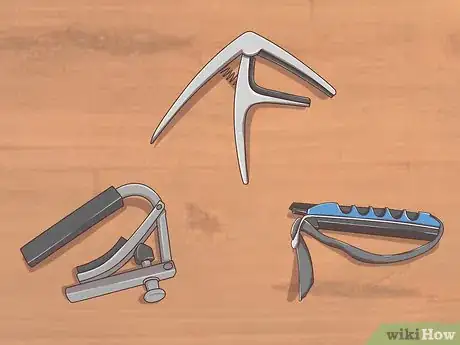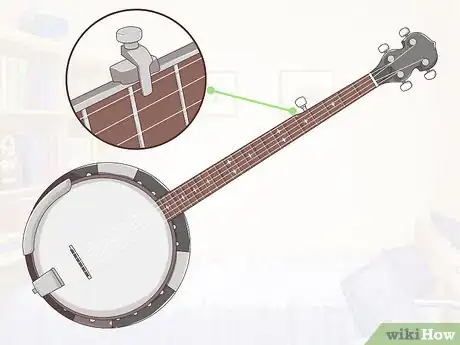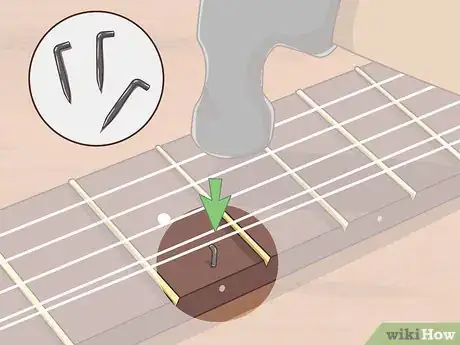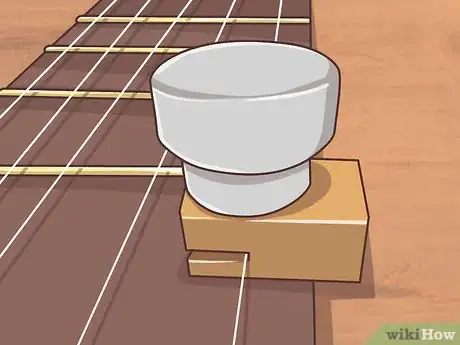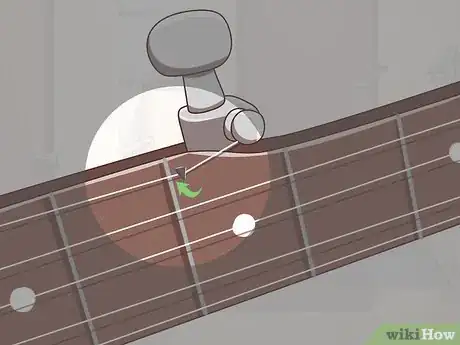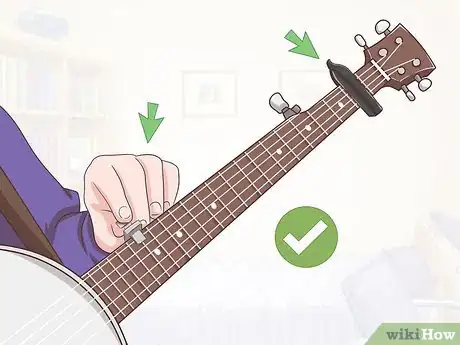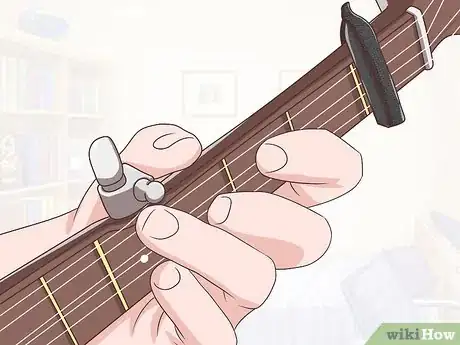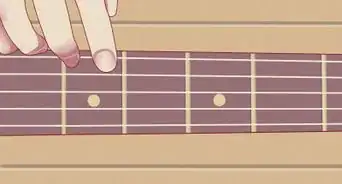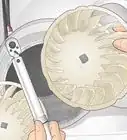This article was co-authored by wikiHow Staff. Our trained team of editors and researchers validate articles for accuracy and comprehensiveness. wikiHow's Content Management Team carefully monitors the work from our editorial staff to ensure that each article is backed by trusted research and meets our high quality standards.
There are 7 references cited in this article, which can be found at the bottom of the page.
This article has been viewed 16,120 times.
Learn more...
Using capos is a quick and easy way to change the key that your banjo is playing in. Most banjos have an elevated fifth string, which requires you to use a separate fifth string capo. This, in conjunction with another capo, will change the key that you're playing in. If you get the right equipment and have a basic understanding of music theory, you'll be able to change the key that you're playing in without having to retune the strings on your banjo.
Steps
Deciding Which Capos to Purchase
-
1Get a traditional capo for the first four frets. You can purchase capos at music stores or online. There are three conventional capos that you can get for the first four frets of the banjo. These include the elastic, clamp, and screw capos. Compare the three different kinds of capos online and choose one that meets your needs and fits in your budget.[1]
- Elastic capos are often the cheapest but least exact kind of capo.
- Clamp capos use a spring to create tension.
- Screw capos allow you to adjust the tension of the capo and are the most popular for banjos.
-
2Use a sliding capo for the fifth string. A Shubb sliding capo is made specifically for banjos and can slide up and down the neck past the fourth fret. Shubb capos should be professionally installed by a luthier or banjo professional because they have to be screwed into the neck of the banjo.[2]Advertisement
-
3Get railroad spikes installed past the fourth fret. Railroad spikes are placed in holes that are punched into the frets under the fifth string and can be used as a capo for your fifth string. Take your banjo to a luthier or professional that works on musical string instruments so they can install it for you. Typically railroad spikes are installed between the seventh and tenth frets.[3]
Using Different Kinds of Capos
-
1Put the capo close to the fret. Tighten the capo as close as you can to the fret without being on top of it. This will prevent your capo from pulling your strings out of tune.[4]
-
2Don't tighten the capo too much. Tightening the capo too much can cause a buzzing sound and will pull your banjo strings out of tune. Instead, tighten them just enough to get a clear sound out of your strings when you play them. Strum a string as you tighten the capo until you get a clear sound from the string.[5]
-
3Unscrew and slide a sliding capo. To use a sliding capo, turn the small screw on the top of the capo counter-clockwise until it's loose. You can then slide the capo back and forth until it's on the fret that you want.[6]
- A Shubb sliding capo must be installed by a professional and requires screwing into the neck of your guitar.
-
4Turn the screw on top of the capo clockwise to tighten it. Screw capos work like sliding capos, except they don't slide across the neck and must be manually moved. Position the screw capo where you want it, then tighten it by turning the screw on the top of the capo clockwise.[7]
- Reagan capos are small moveable capos that you can adjust with a screw on the top and require no installation.
-
5Squeeze the handle on a clamp capo to open it. A clamp capo is held together by tension from a spring. To open the capo, squeeze both of the handles in your hand until the front of it opens. While it's open, position it onto the neck of your guitar on the fret that you want to put it on.
-
6Pull and position the fifth string under a railroad spike. To use the railroad spikes, pull the fifth string under the railroad spike so that the spike rests on top of it. This will hold down the string at the railroad spike and change the note that you're playing on your fifth string.[8]
-
7Wrap an elastic capo around the frets. Elastic capos will have a hook that fits into the hole on the capo to tighten it. Wrap the capo around your desired fret, then take the hook on the capo and loop it through the hole. When applying this capo, make sure that it's tight enough to hold down the bottom four strings on your guitar.
Playing With Capos
-
1Use the capo on the first four strings to change the key. Standard tuning for a banjo is in the key of G. In this case, your strings would be tuned to g, D, G, B, and D. Putting the capo on the first four frets is similar to holding down the frets in a bar chord and can change the key that you're playing in.[9]
- Bringing the capo to the second fret in standard tuning makes you play in the key of A.
- Tightening the capo on the third fret will make you play in the key of B flat.
- Putting the capo on the fourth fret will cause you to play in the key of B.
-
2Use a fifth fret capo in conjunction with your other capo. Pressing down the fifth string with a capo will change its note and works with the capo on the first four frets to change the key that you're playing in.[10]
- For example, when playing in the key of A, your first capo will go over the second fret while your other capo holds down the 7th fret for the 5th string.
- If you are playing in the key of B, your fourth fret should be held down by your traditional capo while the 9th fret is held down by your fifth string capo.
-
3Use capos to keep the same chord shapes while changing the key. The point of a capo is to change the key of the banjo easily, without having to retune it. An additional benefit, however, is the ability to keep standard chord shapes while playing in a different key. For instance, if you know a song in the key of G, you can capo the second fret on the bottom four strings, and the seventh fret on the fifth string and use all of the same finger positions. The capo will do all the work and change the song from the key of G to the key of A.[11]
References
- ↑ http://www.banjowizard.com/capos.htm
- ↑ http://www.frets.com/FretsPages/Musician/Banjo/5thCapo/5thcapo.html
- ↑ https://creekdontrise.com/tabs_instr/banjo_tabs/beginning_5_string/beginning_five_string_11.htm
- ↑ https://www.youtube.com/watch?v=YrgkF6QtUIU&feature=youtu.be&t=1m5s
- ↑ https://www.youtube.com/watch?v=YrgkF6QtUIU&feature=youtu.be&t=1m29s
- ↑ http://www.frets.com/FretsPages/Musician/Banjo/5thCapo/5thcapo.html
- ↑ http://www.frets.com/FretsPages/Musician/Banjo/5thCapo/5thcapo.html
- ↑ https://www.deeringbanjos.com/blogs/faqs/10368713-what-are-capos-spikes-and-fifth-string-capos
- ↑ https://www.deeringbanjos.com/blogs/faqs/10368713-what-are-capos-spikes-and-fifth-string-capos
